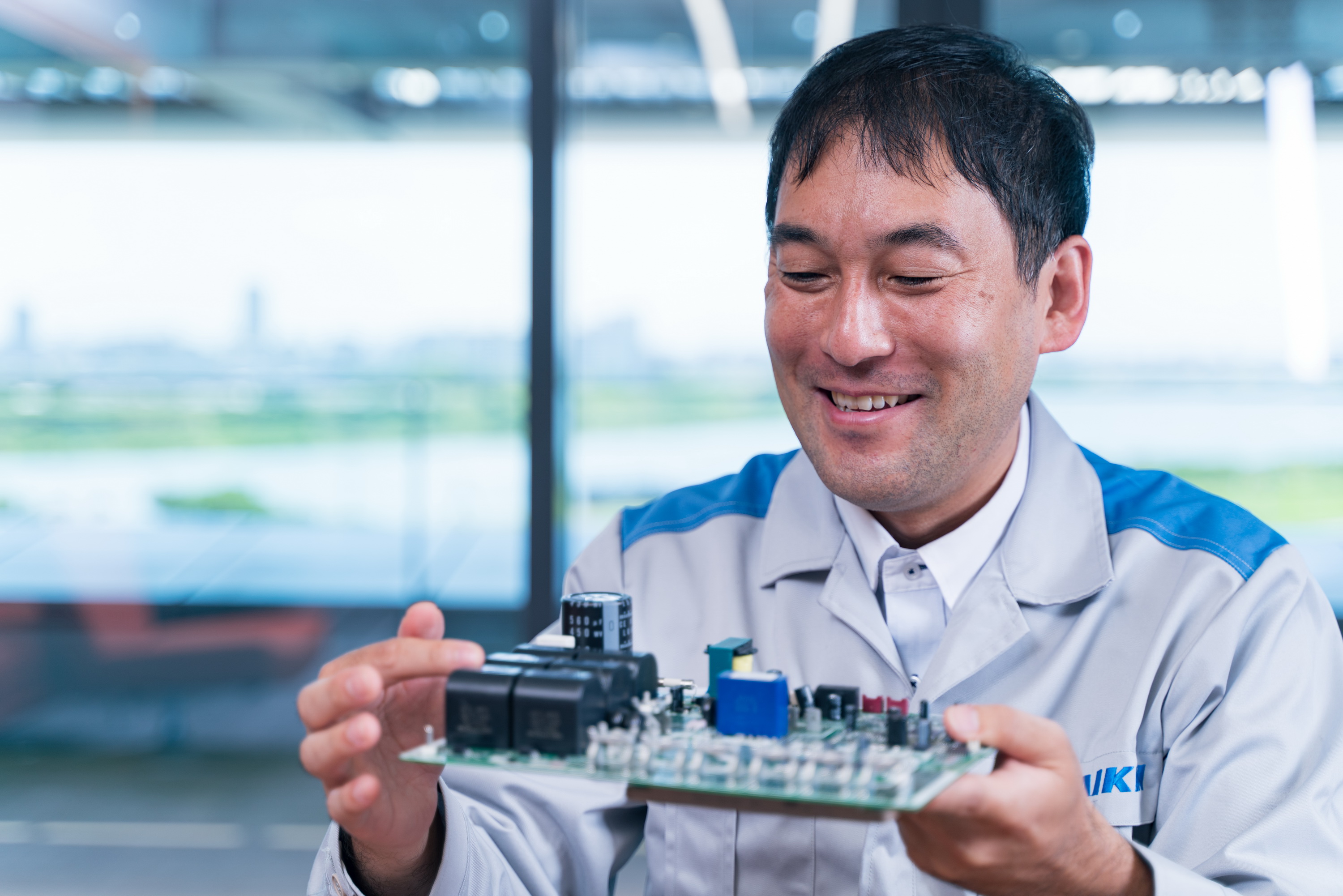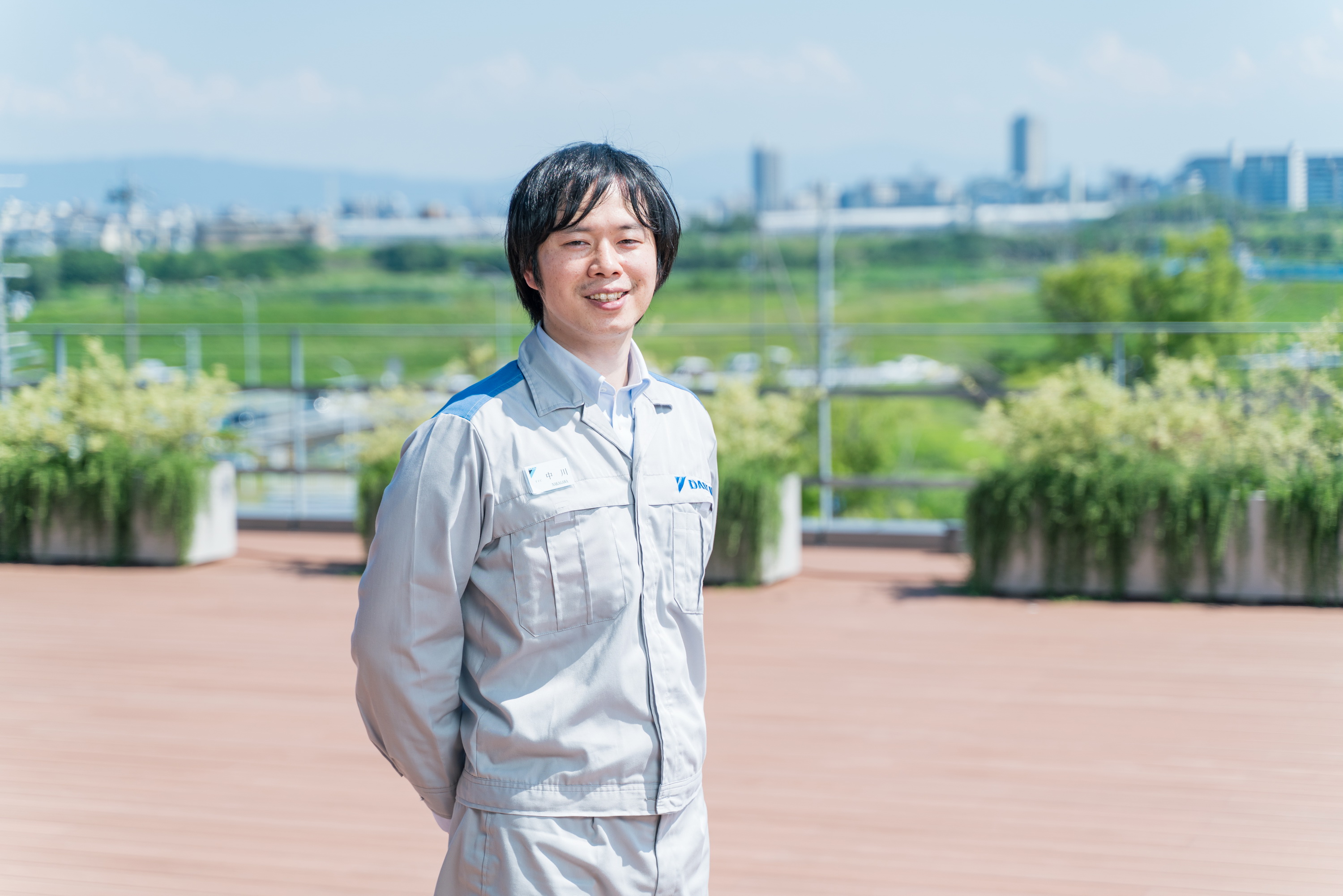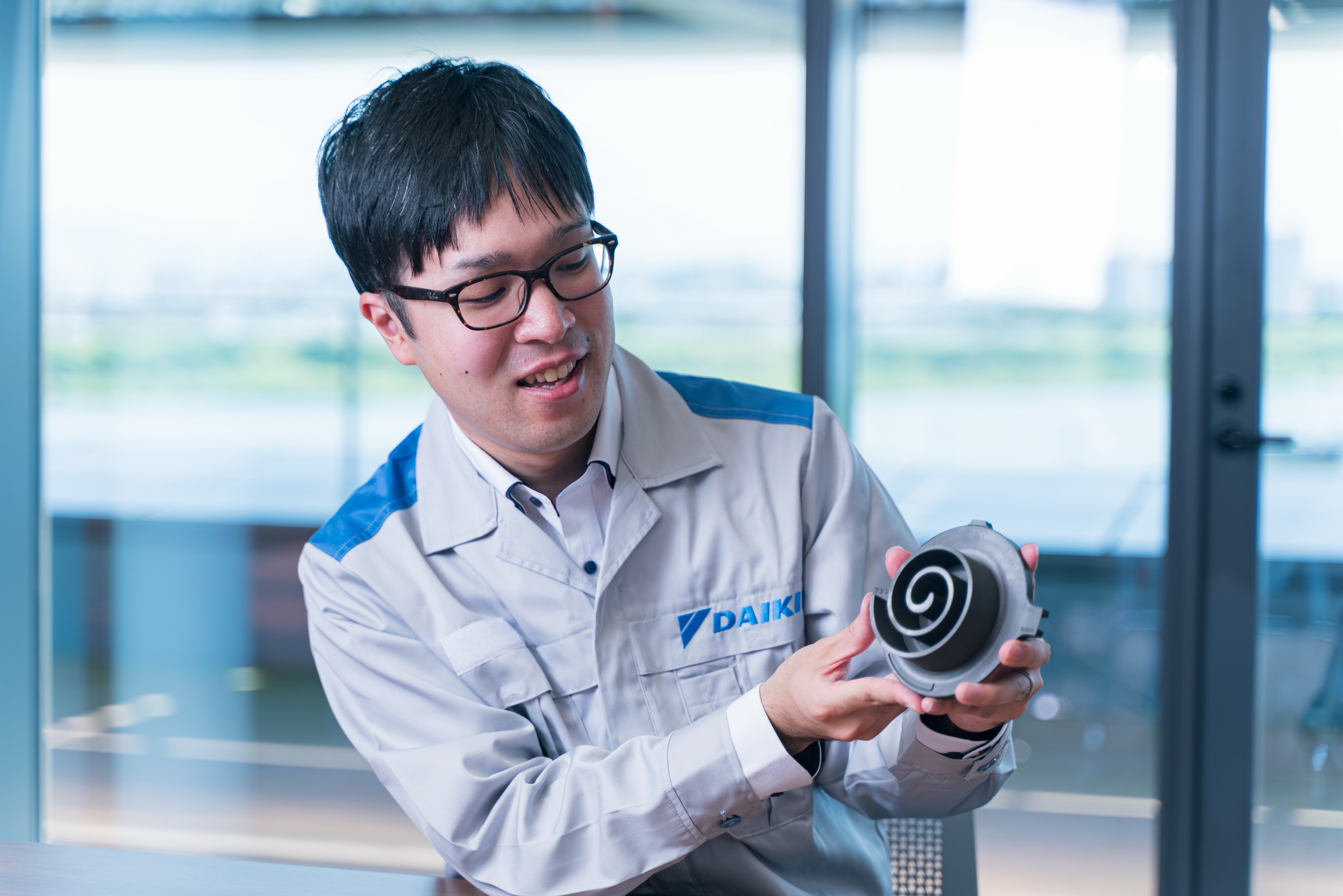Daikin Succeeds in World’s First All-Aluminum Microchannel Heat Exchanger Overcomes technological standstill to reach new plateau in thermal efficiency
Daikin designs many world-first technologies for its air conditioners. For example, to increase thermal efficiency, it worked to improve the performance of its heat exchanger, a vital elemental component of the air conditioner, and succeeded in developing a new all-aluminum microchannel heat exchanger suitable for both heating and cooling operations. Yoshio Oritani, senior engineer and group leader at the Technology and Innovation Center (TIC), led the team responsible for its development. We interviewed him to learn the story behind this outstanding feat.
Meeting the need for energy savings with lighter, more compact air conditioners
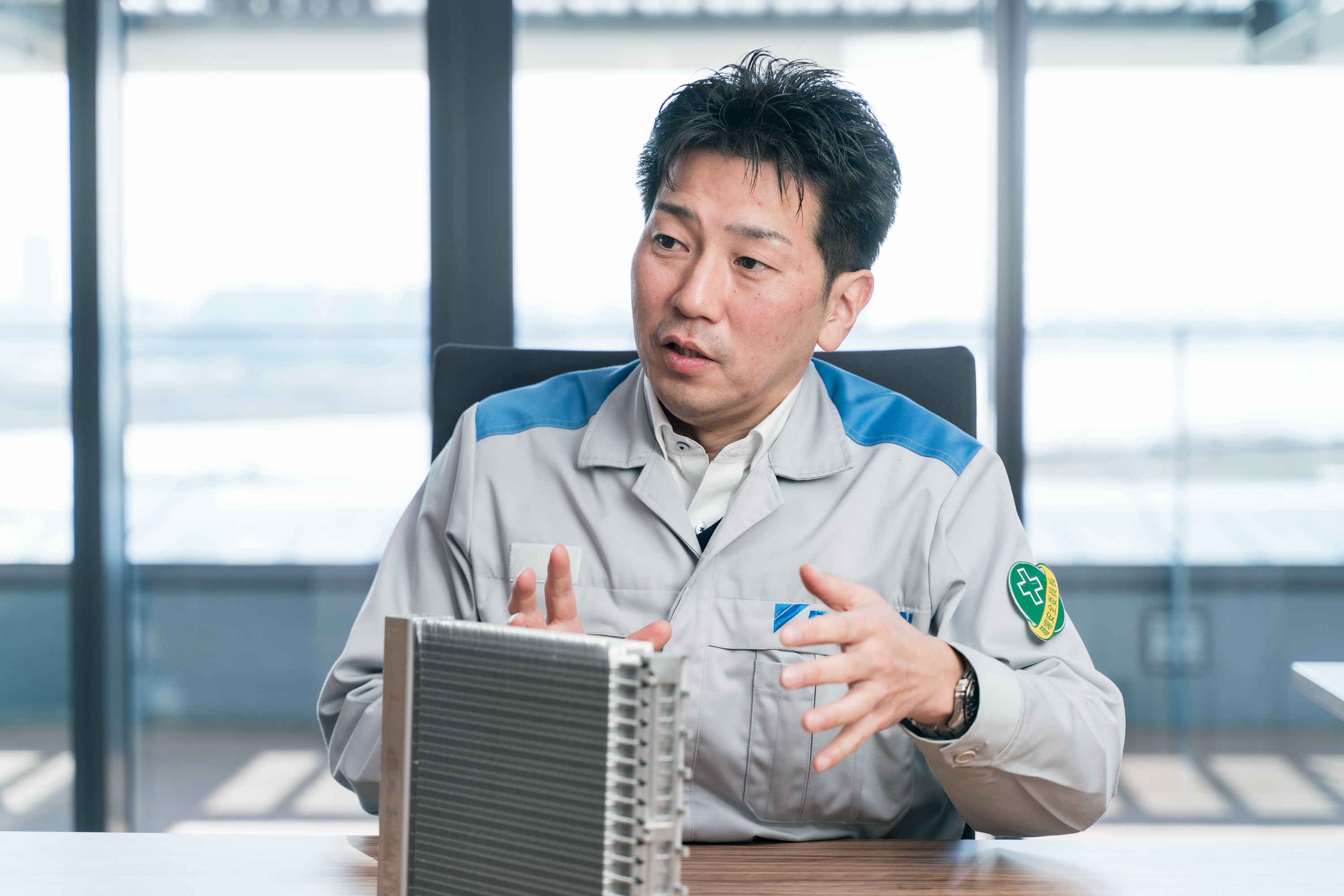
--Can you describe your career before joining Daikin and then your responsibilities after entering the company?
Oritani: I entered Daikin in 2003, so I have been with the company for about 20 years now. I performed research in a thermal-fluids lab at university and worked at Daikin under an internship program for about a month. Thinking it was a very good company, I put in my application. After being hired, I worked in the AC Manufacturing Division until 2020. There I developed products focused mainly on heat exchangers. Later I was transferred to TIC, where I’ve been responsible for advanced development of heat pumps and elemental technologies for heat exchangers and blowers.
--How did development of the all-aluminum microchannel heat exchanger come about?
Oritani: The project began gaining traction in 2010. Energy efficiency regulations for air conditioning equipment were being tightened every year with the aim of preventing global warming. Revision of the Energy Conservation Law was set for 2015, making it crucial for us to improve the energy-saving performance of commercial air conditioners ahead of the revision.
The outdoor unit of an air conditioner has three main components: the compressor at its heart, the heat exchanger in the rear, and a fan that sends airflow. Among these, the heat exchanger, which I was in charge of, transfers heat from the circulating refrigerant to the air. Increasing the efficiency of the heat exchanger generally requires increasing its size.
However, demands for lighter weight and smaller size from the perspective of installation and transportation required us to resolve a variety of conflicting issues. Similarly, lessening the environmental impact made it vital for us to reduce the amount of refrigerant, which impacts global warming. This led us to search for a completely new technology that could achieve high efficiency, compactness, and refrigerant savings without increasing weight or refrigerant volume.
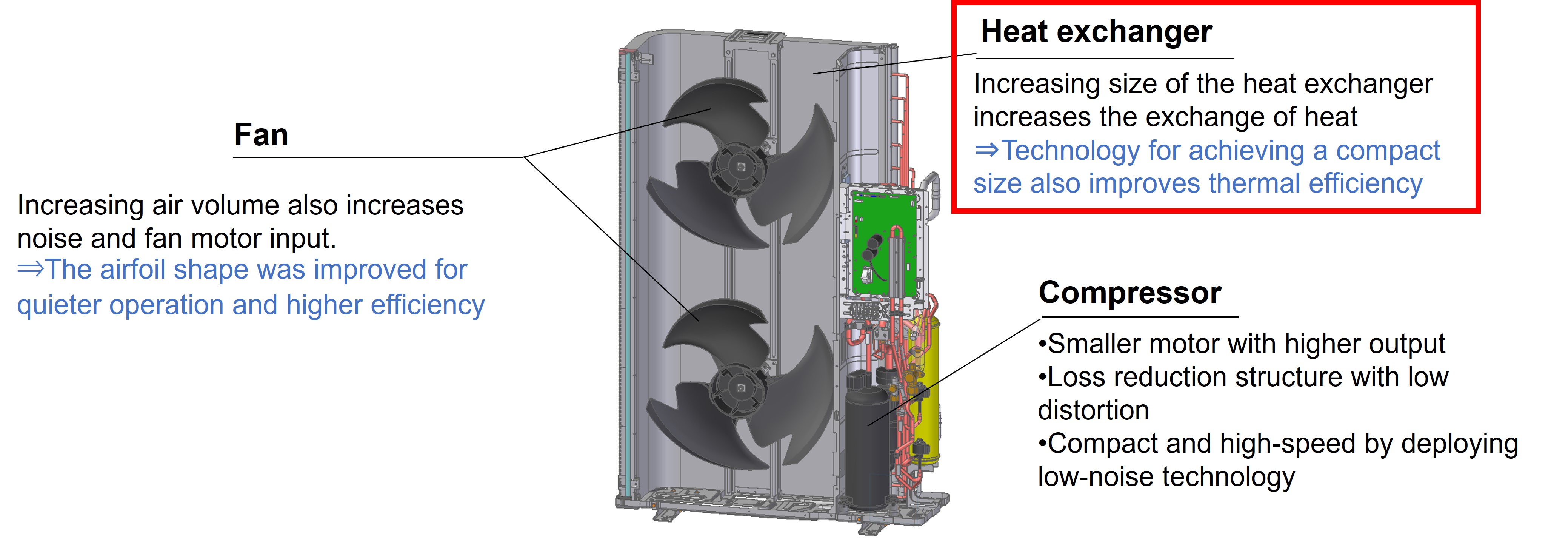
Development of energy efficient air conditioners depends on resolving issues relating to fans, heat exchangers, and compressors, which are the main components of air conditioners.
How thermal efficiency improved within the limitations of conventional technology
Oritani: In general, to improve the thermal efficiency of a heat exchanger, it is important to increase the heat transfer coefficient. To achieve this, there are three key points: improving the heat transfer coefficient from the fins of the aluminum plate to the air, improving the heat transfer coefficient of the heat transfer tube through which the refrigerant passes, and reducing the thermal resistance of the fin and heat transfer tube joints.
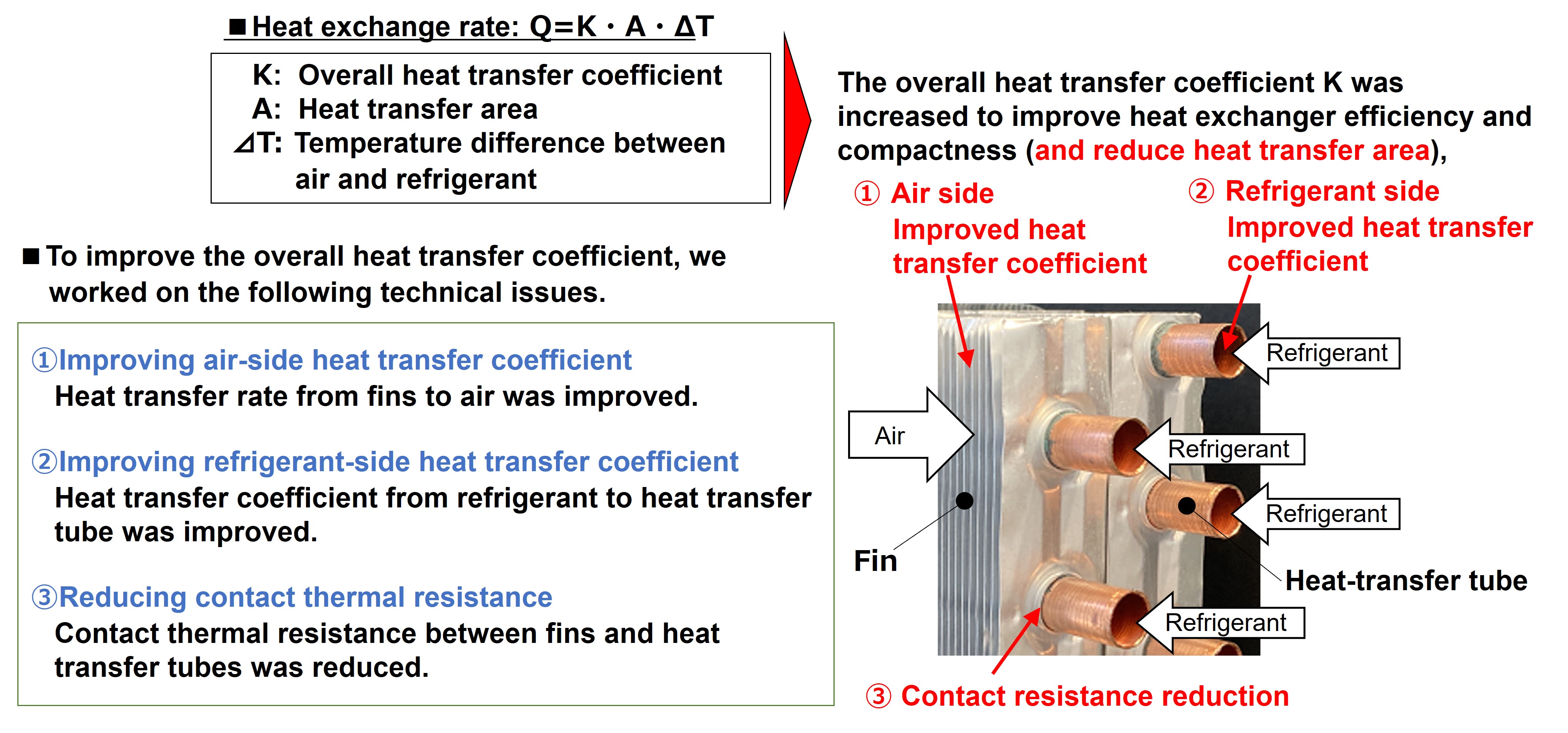
The key design point for improving efficiency in conventional heat exchangers is to increase the overall heat transfer coefficient so that the amount of heat exchanged is greater.
First, the heat transfer coefficient on the air side is improved by making the heat transfer tubes thinner, which reduces the ventilation resistance of the air hitting the tubes, and by densely arranging the tubes for higher integration. Heat transfer is also enhanced by improving the fin shape and adding slits and louvers.
On the other hand, heat transfer on the refrigerant side also improved by increasing flow velocity (flow rate) of the refrigerant flowing through the heat transfer tube and by grooving the inner surface of the tube to make the refrigerant turbulent. In addition, the joint between the heat transfer tube and fins, which had been attached by mechanical contact, has now been brazed (a type of welding using melted filler metal) to reduce thermal resistance by eliminating the gap (air layer) at the joint.
While improvements in conventional heat exchangers have been seen over the past 60 years, thermal efficiency had hit a plateau in the last 10 years, exhibiting only incremental improvements of about 10%. Likewise, tube diameter of the heat transfer tubes also reached a processing limit of 4 mm minimum. Although heat transfer on the refrigerant side had been improved, the pressure loss in the heat transfer tube had also increased, requiring a significant increase in the number of passes (number of tubes). This is where we conceived of the microchannel heat exchanger.
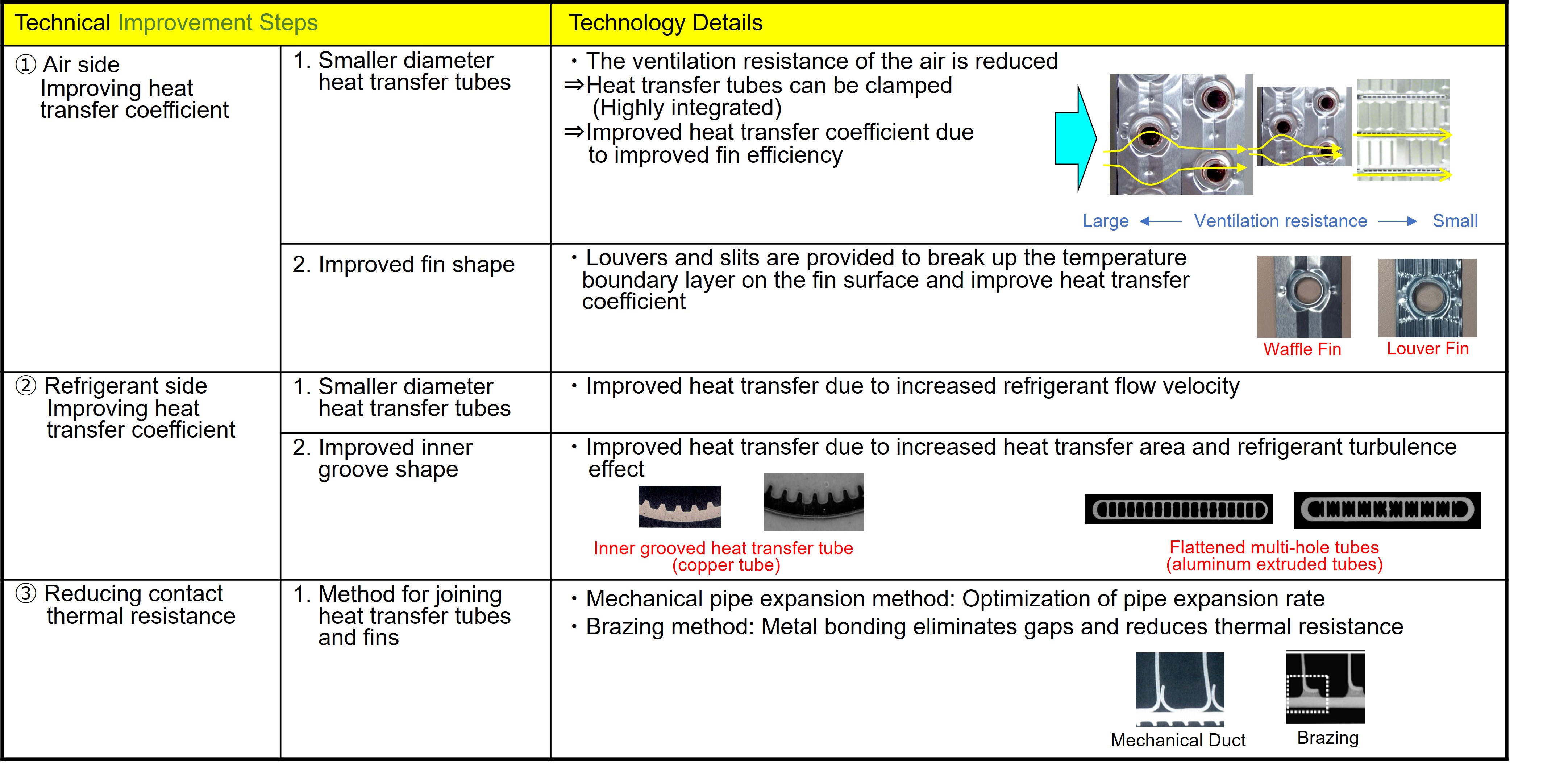
Three technological steps and design points were taken to increase thermal efficiency along with various efforts made to improve the heat transfer coefficient on the air and refrigerant sides and to reduce contact thermal resistance.
New hurdle appears in the development of microchannel heat exchangers for both heating and cooling.
--What exactly is a microchannel heat exchanger?
Oritani: A microchannel is simply a narrow channel for refrigerant. In fact, microchannel heat exchangers are commonly used in automobiles, where they are installed as "condensers" to cool the refrigerant gas in air conditioners, and while microchannel heat exchangers had also been installed in cooling only (condenser only) outdoor units, they had not yet been used in commercial air conditioners (which are also used to provide heating).
The structure of a conventional microchannel heat exchanger looks like this. The heat transfer tube where the refrigerant passes is formed from a circular shape into a very thin flat shape. This flat tube has the "ultimate diameter reduction" with holes about 1 mm in size. In addition, the flat holes are interspersed with bellows-shaped aluminum "corrugated fins" to create a highly layered structure.
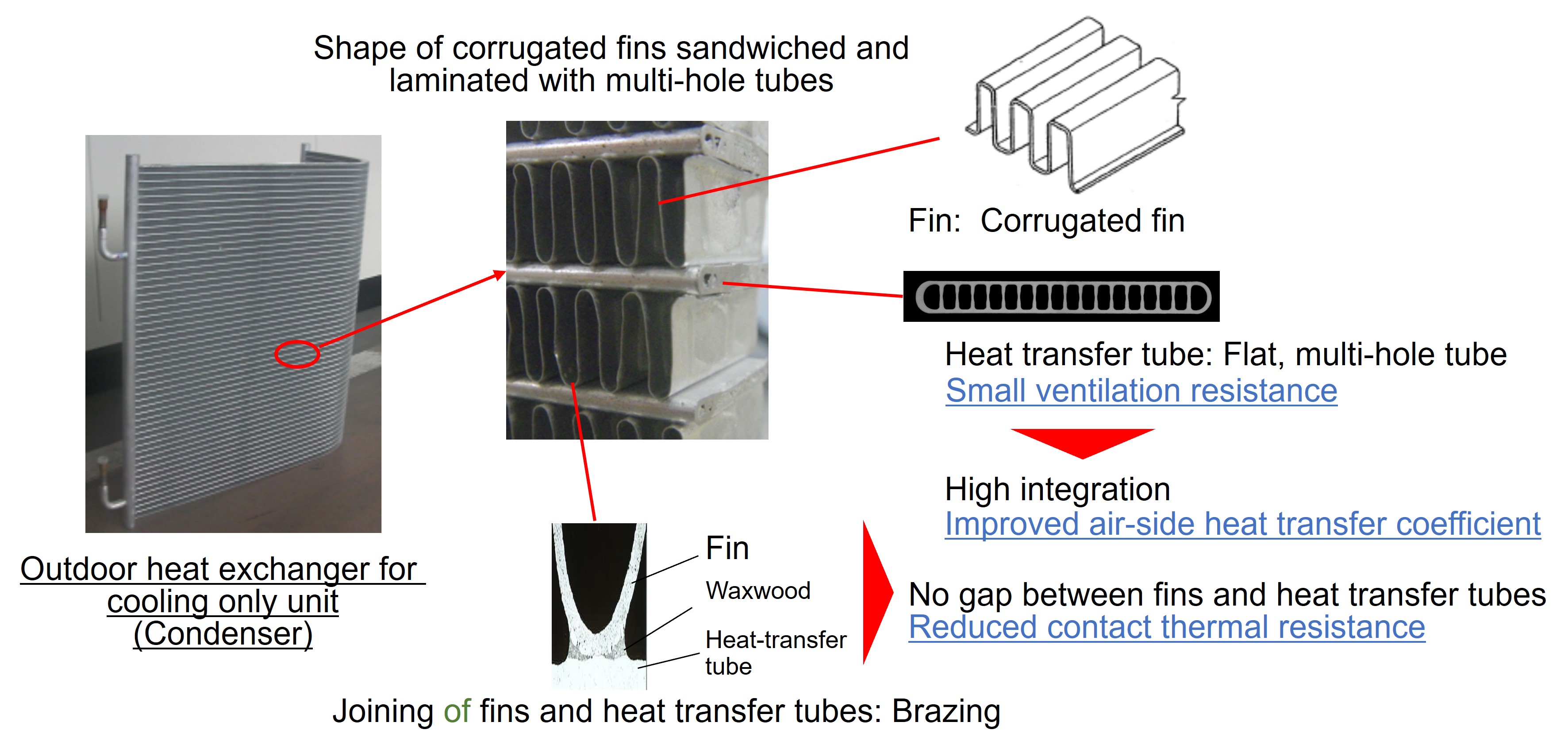
To improve efficiency of conventional heat exchangers, efforts had already been made for microchannel heat exchangers used in cooling only units, but it was difficult to develop one for both heating and cooling.
--What are the benefits of a micro channel exchanger?
Oritani: First, flattening the heat transfer tubes reduces flow path resistance, and thousands of refrigerant flow paths can be highly integrated and arranged, which improves the heat transfer coefficient transmitted to the air side through the fins. All materials have been changed from copper to aluminum, which also contributes to weight reduction. The fins and heat transfer tubes are brazed together. Also, the high integration of the tubes reduces the overall volume (miniaturization), which also reduces the amount of refrigerant that is used.
However, to use a microchannel heat exchanger in an air conditioner that can perform both heating and cooling operations, the heat exchanger must also be equipped to evaporate refrigerant as well as to condense it. To accomplish this, we had three challenges to overcome.
The first issue was water drainage. When an air conditioner is used for heating, moisture in the air condenses inside the outdoor unit and "drain water" is generated. Drain water must be emptied, but the conventional structure with fins divided into upper and lower sections prevents drain water from flowing downward. Therefore, to improve drainage, it was necessary to create new flow channels for the drain water.
The second issue was during heating when refrigerant undergoes a "two-phase" state of gas and liquid. When refrigerant is diverted to a flat tube, the liquid is heavier and collects in the lower part of the tube, whereas the gas, which is lighter, collects in the upper part of the flat tube, resulting in an unbalanced distribution of liquid and gas. Since this leads to a decrease in thermal efficiency, the flow of the refrigerant was analyzed using CAE software, and a device was sought to distribute the refrigerant evenly.
The third issue was pipe corrosion caused by the generated drain water, which made it necessary to bolster corrosion resistance of the aluminum material.
--What ideas did you incorporate for the new micro channels?
Oritani: Regarding the first issue of drainage, the fins were conventionally divided into upper and lower sections, so we improved drainage by inserting a flow channel next to the flat multi-hole tubes of the microchannel to create a new fin and multi-hole tube structure that was connected to the upper and lower sections.

Technology development for heat pump-equipped units improved drain water removal with the design of fins with flat, multi-hole tubes that were inserted from the side and connected at the top and bottom.
The second issue involved a situation in the past when diverting refrigerant to multiple tubes, and refrigerant blew upwardly from the bottom to the top. This method resulted in an uneven distribution of the refrigerant between liquid and gas. Therefore, a new header (multiple flat tubes bundled together) shunt structure was developed to circulate the refrigerant from bottom to top and top to bottom. This allowed us to achieve nearly 100% distribution performance.
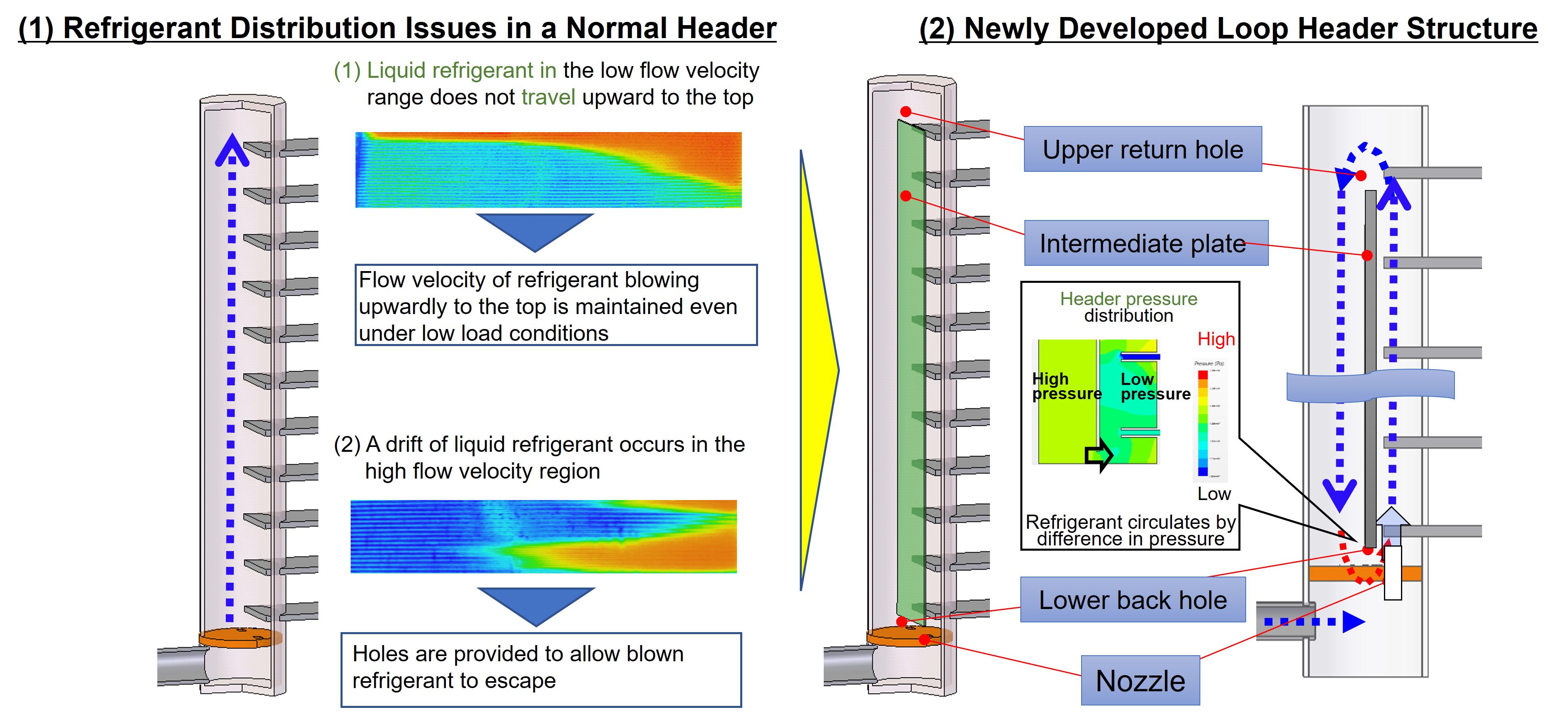
Technology development for heat pump-equipped units enabled the design of a new header diversion structure to suppress the refrigerant drift that occurs during heating.
For the third issue of corrosion resistance, we lacked the needed material technology, so we developed it jointly with UACJ Corporation (formerly Sumitomo Light Metal Industries). The fins, multi-hole tubes, headers, and solder material are all made of aluminum, but the actual composition of additives such as zinc is slightly different. This improved the corrosion resistance of the heat-transfer tubes.
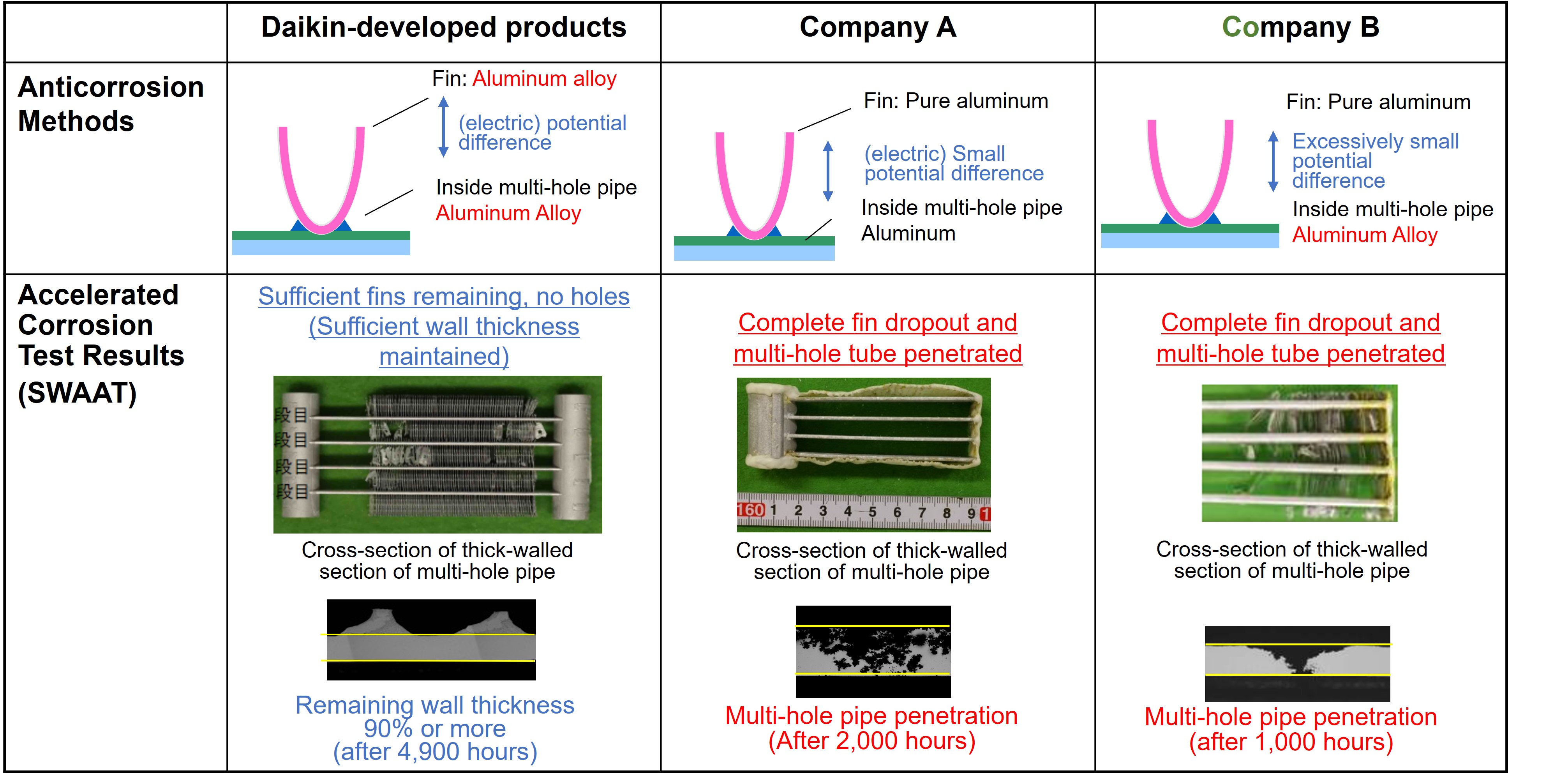
Technology was developed for units equipped with heat pumps, and corrosion resistance was improved by blending a small amount of zinc instead of pure aluminum.
Confronting mass production hurdles in a united effort for a 100% yield rate
--Were there any particularly difficult moments in this project that gave you a sense of accomplishment after overcoming them?
Oritani: Well, I’ll spare you the details, but the method for mass production was a completely new process, so it was very difficult. In the process of inserting flat multi-hole tubes into the fins, the fins would buckle and collapse. We didn't know how much dimensional tolerance to keep within, and about half of the products were defective. The developer remained on the production line, collecting data and systematically investigating which process caused what kind of defects. Finally, after a year of work, the percentage of defective products closely approached zero. That made all of us ecstatic (laughs).
The brazing process for the fins and multi-hole tubes was also difficult. In the past, we had only joined heat exchanger parts, but the new manufacturing process placed the entire heat exchanger in a huge kiln (furnace) and heated it like you would in a microwave oven while the fins and multi-hole tubes were brazed together using aluminum. Being a new experience for us, we had quite a few brazing defects at first. Not having a kiln on our production line also made it difficult to create a prototype. We went to a UACJ Corporation factory in Nagoya for about six months to gain brazing and kiln know-how.
--So, the product was completed thanks to a series of behind-the-scenes efforts to overcome the hurdles of mass production.
Oritani: That's right. We managed to install the world's first all-aluminum microchannel heat exchanger in a heat pump outdoor unit for both heating and cooling. It was first introduced in the industry's smallest "SkyAir ZEAS series" launched in 2012, and we succeeded in making it compact with a reduction in unit weight from 80 kg to 59 kg. Its smaller size also led to a reduction in refrigerant and CO2 emissions.

First launched in 2012, the SkyAir ZEAS series was equipped with a micro-channel heat exchanger developed to be environmentally conscious, lightweight, and compact.
A new updated version of the ZEAS series was released in 2015. There are two models here: the FIVE STAR ZEAS, the top-of-the-line model with the industry’s No. 1 energy-saving performance, and the Eco-ZEAS, which was a smaller model. This microchannel heat exchanger was also adopted in the VRV 6 series, a large-capacity outdoor unit for buildings launched in 2018.
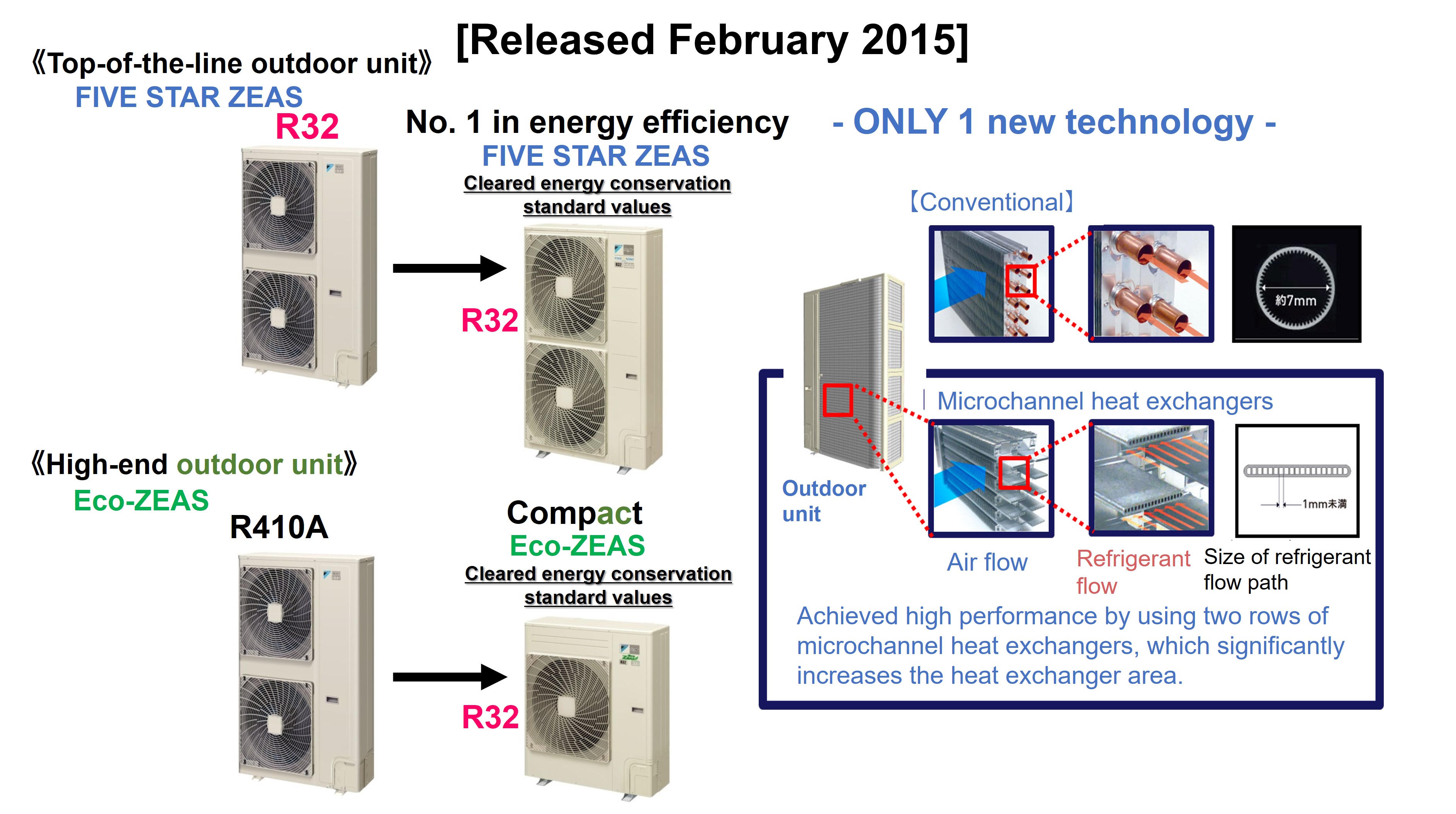
Two more newly updated models with microchannel heat exchangers were unveiled in 2015 to become No. 1 in energy efficiency and compactness.
--Finally, do you have any advice for possible future colleagues interested in joining Daikin?
Oritani: Developing a new revolutionary product, such as a microchannel heat exchanger used for both heating and cooling, requires time and money. I believe that this kind of development is only possible for a manufacturer like Daikin specializing in air conditioners. The good thing about our company is that once we decide to do something, everyone involved works together to focus on it enthusiastically. In fact, we have an environment and culture that encourages this. If you want to take on new challenges, please join us.
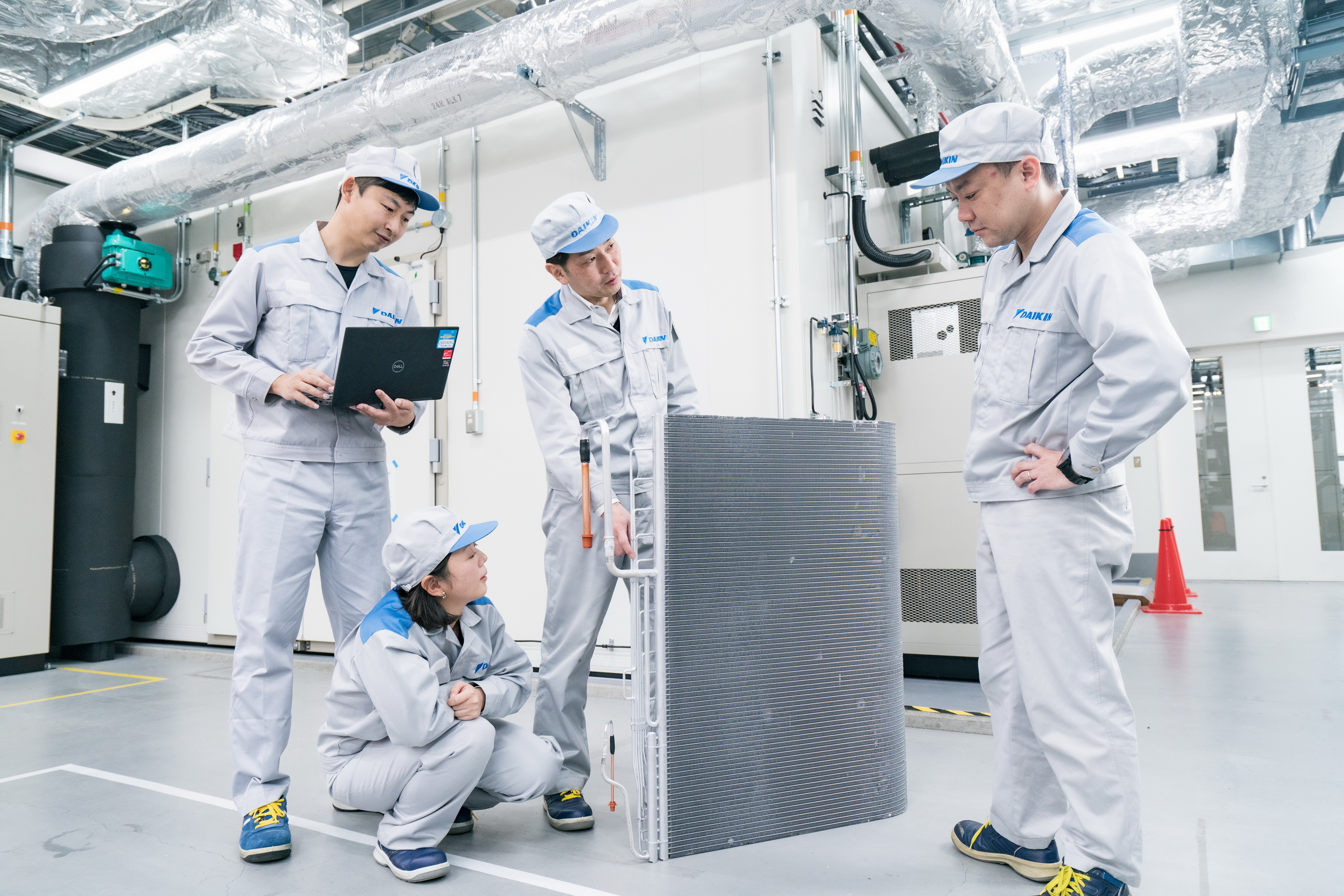
Yoshio Oritani
Chief Engineer, Technology and Innovation Center
Born in Osaka and joined the company in April 2003. He is in charge of refrigeration cycle technology, heat exchanger technology, and blower technology.
“I would like to make our company the No. 1 engineering group in the world and continue to take on the challenge of developing technologies that will leave our mark on the world stage.”
関連記事


















